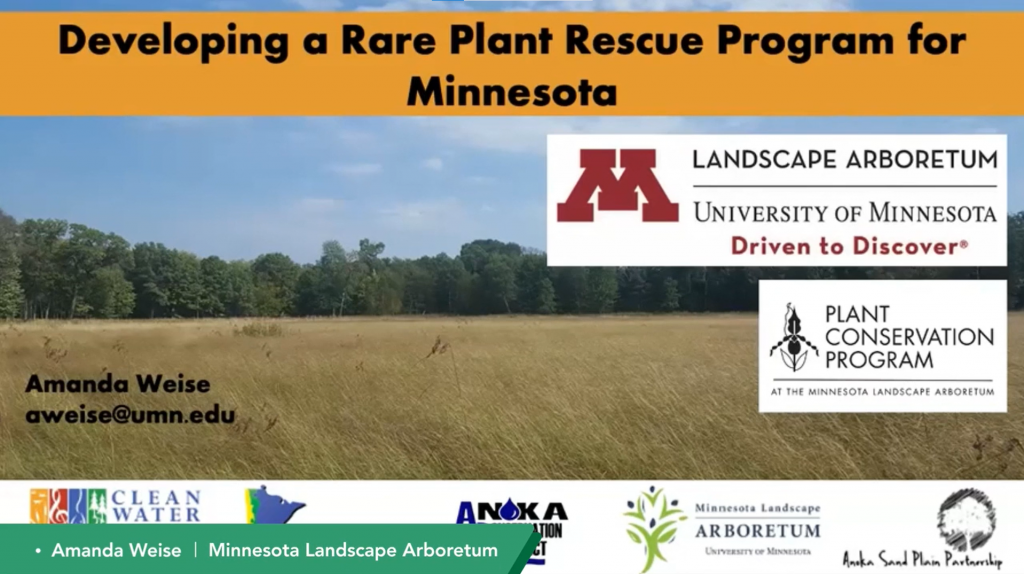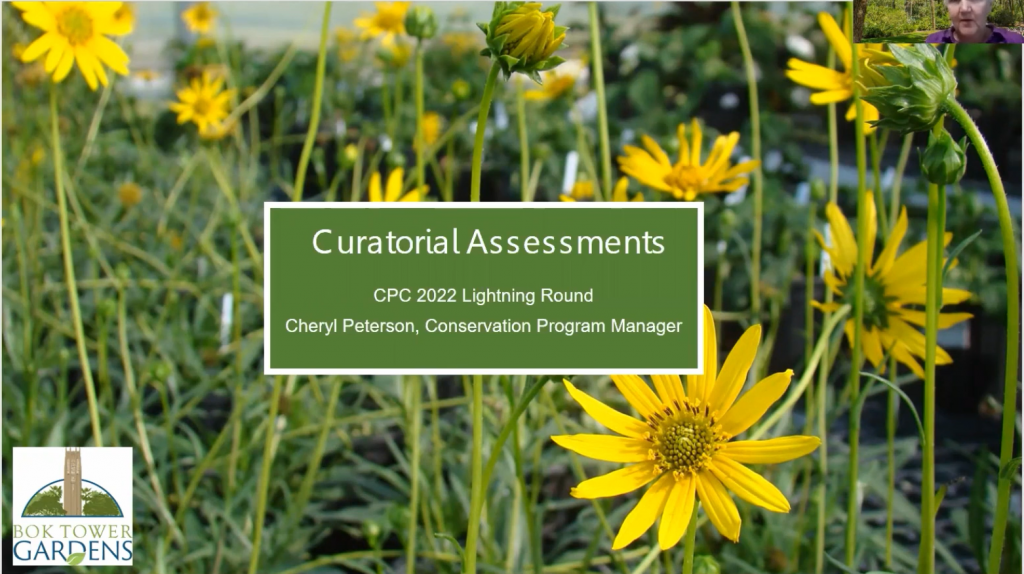
Mercer Botanic Gardens, a Harris County botanical park facility, began endangered native plant conservation efforts in 1986 with the ex-situ conservation (seed banking and propagation) of a local federally listed species, Texas prairie dawn, Hymenoxys texana, Asteraceae (G2) and its rare saline prairie associates. Mercer became a participating institution for the Center for Plant Conservation […]
Read More…

There are 179 plant species listed as threatened or endangered in Minnesota. By definition, these plants are rare and vulnerable to extinction. Over the past three decades, thousands of rare plants have been legally destroyed as a part of permitted development activities. In 2019, the MN-DNR created a new permit option that allowed for the […]
Read More…

The Rare Plant Conservation Program at Bok Tower Gardens maintains rare plant germplasm of north and central Florida endemic species as either living plants or in a seed collection. There are currently ~2,000 plants and over 2 million seeds of 70 species in the ex situ collection. Each year, a subset of seeds are withdrawn […]
Read More…

As the number of plant species thought to be exceptional, or unable to be seed banked using traditional methods, grows, so too does the need for information on these species. However, there’s a critical lack of information on successful long-term storage protocols for many exceptional plants, and a greater number that haven’t yet been evaluated […]
Read More…

The Amargosa River Basin in Inyo County, California, is home to at least 19 rare, threatened, and endangered plant species, three of which are federally listed; the Amargosa niterwort (Nitrophila mohavensis), the Ash Meadows gumplant (Grindelia fraxinipratensis) and the spring-loving centaury (Zeltnera namophila). Threats to the listed plant species of the Amargosa River Basin include […]
Read More…

Quercus oglethorpensis Duncan (Oglethorpe oak) is an endangered species native to the southeastern United States, where it sporadically occurs in small populations both on protected and unprotected land. Despite its southern distribution, Q. oglethorpensis has demonstrated cold-hardiness and adaptability when cultivated outside its native range at The Morton Arboretum (Lisle, IL) and could be suitable […]
Read More…

In the past 5-years, the work of over 12-years of monitoring and applied conservation has realized many successes and struggles on the globally-rare, New England endemic Jesup’s milk vetch (Astragalus robbinsii var. jesupii). Experimental augmentation from grown plants, augmentation with seed, and genetic analysis for use of seeds in augmentation across genetically-isolated provenances. We will […]
Read More…

Growing native orchids from seed is a challenging and long-term task with many research opportunities. Symbiotic germination, where orchid seeds are inoculated onto an actively growing culture of known orchid mycorrhizal fungi (OMF), is the primary way to ensure that laboratory propagated orchid seedlings establish a fungal relationship. Despite reports on increased and faster germination […]
Read More…

Small-whorled pogonia (Isotria medeoloides (Pursh) Raf.) is diminutive terrestrial orchid and one of the rarest in North America, with a disjunct distribution from Maine and Georgia. This orchid is associated with mid-successional forests and it is believed that late successional forests are too shady to support this species. Experiments conducted in northern US states concur […]
Read More…

Working with multiple partners since 2016, Jacksonville Zoo and Gardens has surveyed for new and monitored known populations of P. chapmanii in NE Florida. JZG works with stakeholders to not only identify land management strategies that ensure P. chapmanii is allowed to persist in these locations, but also has an opportunity to reproduce. This typically […]
Read More…

American Public Gardens Association and the United States Forest Service are partnering to establish living gene banks of tree species at risk in public gardens. Efforts focus on exceptional taxa native to U.S. forests which cannot be conserved through traditional seed banking methods. Our Tree Gene Conservation Partnership annually awards matching funds to Association members […]
Read More…

As climate change continues to influence ecosystems, arboreta and botanical gardens are often faced with the challenge of developing strategic plans that can ensure native plant conservation for years into the future. Extreme weather conditions are now well-known and many impacts are already evident. Arboreta and other public gardens provide an ideal setting in which […]
Read More…

Scotts Valley Polygonum (Polygonum hickmanii) is an endangered annual species known from a single extant population. With steeply declining numbers of plants in situ and few seeds in storage, we used a close relative to confirm our germination technique and nursery protocols to grow for seed production. We were successful in producing over 90,000 seeds […]
Read More…

The ex-situ conservation of magnolias plays a crucial role in preserving the species red-listed by IUCN, and it is generally limited to field collections. The cryobiotechnology (i.e., plant tissue culture and cryopreservation) can help safeguard the biodiversity of plants and reduce the cost of maintenance and the risk of loss for the collection. Studies on […]
Read More…

Human activities have decreased genetic diversity in a variety of animal species managed for conservation efforts, yet little is known about how similar human practices impact managed plant species. We show that prioritizing rapid propagation imposes a genetic bottleneck that limits genetic diversity. Among three species of wild violets commonly used in restoration efforts, genetic […]
Read More…

Quercus dumosa, or Nuttall’s scrub oak, is endangered due to human encroachment, misidentification, disease, and wildfire. Micropropagation is a method of ex situ conservation in which plants maybe be preserved under aseptic conditions away from the many threats they face. However, each genotype grows differently; what may encourage growth in one individual may prove lethal […]
Read More…

The remote archipelago of Hawaii in the Pacific Ocean is a hotspot of endemism with nearly 90% of the native flora being endemic to the islands, many being single-island or even narrower endemics. Seed banking has been recognized as the most efficient and cost-effective means of ex situ plant conservation, however not all species can […]
Read More…

The North American Botanic Garden Strategy for Alpine Plant Conservation (the Alpine Strategy), published in 2020, is making progress towards completing several targets, and we’d like to share some of these exciting updates as well as highlight opportunities for researchers and organizations to participate. The Alpine Strategy is a blueprint for protecting alpine plants and […]
Read More…

















